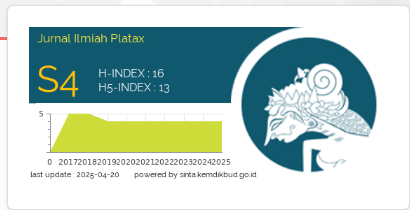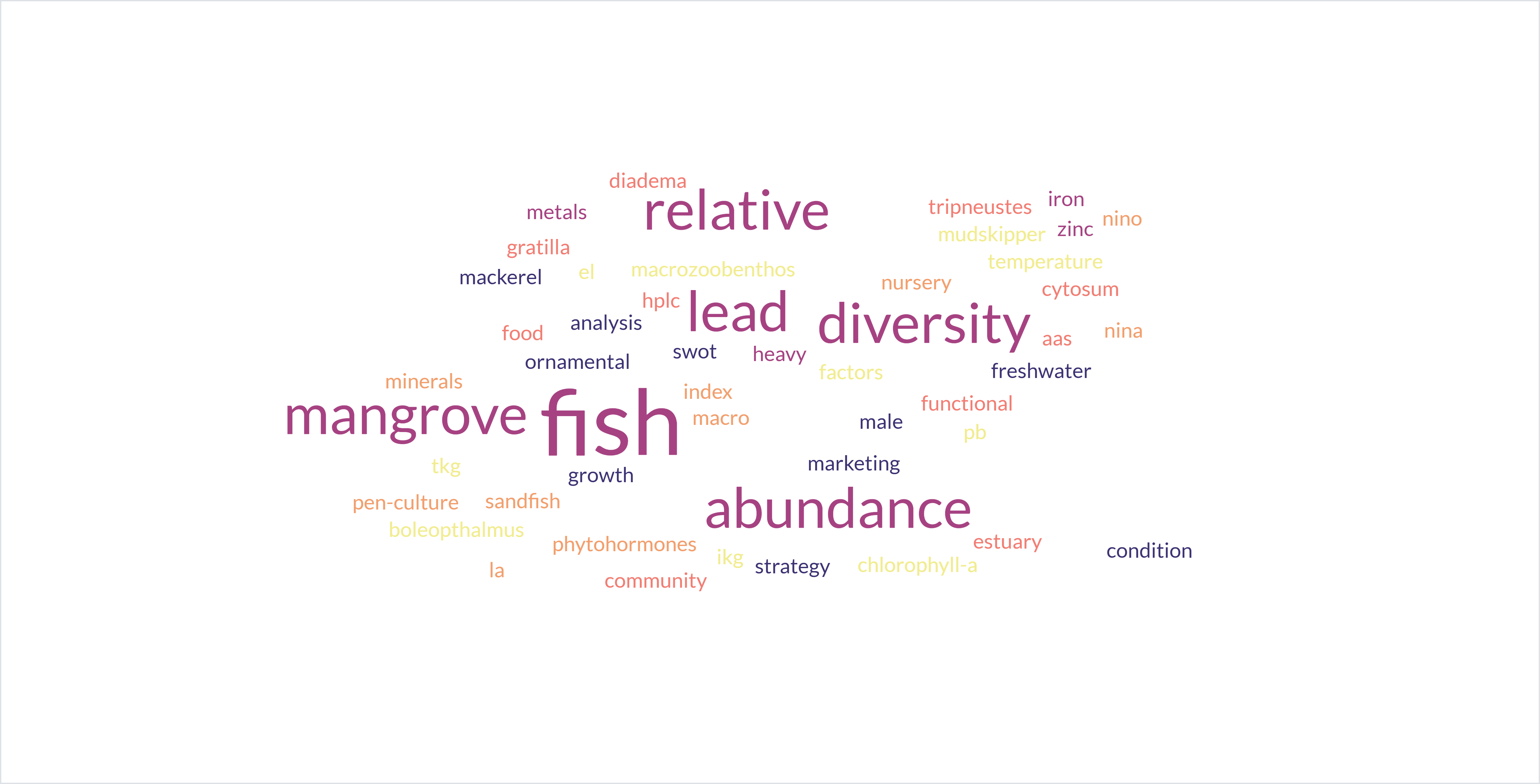Identification Of Marine Debris By Focusing The Study Of Clean Coast Index On Karang Ria Tuminting Beach
DOI:
https://doi.org/10.35800/jip.v11i1.44018Keywords:
Marine debris;, Index;, Identification;Abstract
Marine debris is rapidly gaining worldwide recognition as a major anthropogenic threat to global ocean ecosystems and produces a wide range of negative environmental, economic, safety, health and cultural impacts (UNEP, 2009). East Asia is the region with the fastest growing waste production in the world. Indonesia is in second position after China which produces the most waste in the world (Jambeck et al, 2015). The Beach Hygiene Index is a scaled index in a “Clean Coast” program launched by the Israeli ministry in an effort to solve the problem of littering on Israel's beaches. This index can be used as an indicator of pollution in a marine tourism area. The purpose of this study was to identify types of marine debris in the coastal waters of Karang Ria Tuminting and determine the value of the Clean Coast Index as an indicator of pollution. The collected data was then processed and statistically analyzed using Excel, Orange and SPSS software. Sampling was done by adapting the Shoreline Survey Methodology. approximately 1 month and made 2 direct observations, the plastic and rubber waste categories were found as the most common categories with the first observation being 73.4% and the second observation being 10.1%. The activities of the surrounding community are the main factors causing the abundance of marine debris around the coastal areas. The index value obtained is 39.5 with a total of 395 waste in various categories as stated by NOAA (2016).
Keywords: Marine debris, Index, Identification, Category
ABSTRAK
Sampah laut dengan cepat mendapatkan pengakuan dunia sebagai ancaman antropogenik utama bagi ekosistem lautan global dan menghasilkan berbagai macam dampak negatif lingkungan, ekonomi, keselamatan, kesehatan, dan budaya (UNEP, 2009). Asia Timur adalah wilayah dengan pertumbuhan produksi sampah tercepat di dunia. Indonesia berada pada posisi kedua setelah China yang memproduksi sampah terbanyak di dunia (Jambeck et al, 2015). Indeks Kebersihan Pantai adalah skala indeks dalam suatu program “Clean Coast” yang diluncurkan kementerian Israel dalam upaya untuk memecahkan permasalahan sampah di pantai-pantai Israel. Indeks ini dapat digunakan sebagai indikator polusi pada suatu kawasan wisata bahari. Tujuan penelitian ini untuk mengidentifikasi jenis sampah laut di perairan pantai Karang Ria Tuminting dan menentukan nilai Indeks Kebersihan Pantai (Clean Coast Index) sebagai indikator polusi. Data yang dikumpulkan kemudian diolah dan dianalisis secara statistik dengan menggunakan perangkat lunak Excel, Orange dan SPSS. Pengambilan sampel dilakukan dengan mengadaptasi metode Shoreline Survey Methodology. Pengamatan dilaksanakan kurang lebih 1 bulan dan dilakukan 2 kali pengamatan langsung, diperoleh kategori sampah plastik dan karet sebagai kategori yang paling banyak ditemukan dengan komposisi jumlah pada pengamatan pertama sebesar 73.4% dan pengamatan kedua sebanyak 10.1%. aktivitas masyarakat sekitar menjadi faktor utama penyebab berlimpahnya sampah laut di sekitar wilayah pesisir. Nilai indeks yang diperoleh yaitu sebanyak 39,5 dengan jumlah total 395 sampah dengan berbagai kategori sesuai dengan yang dikemukakan oleh NOAA (2016).
Kata kunci : Sampah laut, Indeks, Identifikasi, Kategori
References
Alkalay, R., Pasternak, G., & Zask, A., 2007. Clean-coast index—A new approach for beach cleanliness assessment. Coastal Management 12.
CBD, S. G., 2012. Impacts of Marine Debris on Biodiversity: Current Status and Potential Solutions. Technical Series No, 67.
Cordova, M. R. 2017. Pencemaran plastik di laut. Oseana,
Crawford, C. B., & Quinn, B., 2017. “Microplastic Pollutant”. Elsevier.
Dias, B. D. S., 2016. Marine debris: understanding, preventing and mitigating the significant adverse impacts on marine and coastal biodiversity. CBD technical series.
Djaguna, A., Pelle, W. E., Schaduw, J. N., Manengkey, H. W., Rumampuk, N. D., & Ngangi, E. L. 2019. Identifikasi sampah laut di pantai tongkaina dan talawaan bajo. Jurnal Pesisir dan Laut Tropis.
Fajriah, S. D., & Mussadun, M. 2014. Pengembangan sarana dan prasarana untuk mendukung pariwisata pantai yang berkelanjutan (studi kasus: kawasan pesisir pantai Wonokerto kabupaten Pekalongan). Jurnal Pembangunan Wilayah dan Kota,
GESAMP 2015. Sources, fate and effects of microplastics in the marine environment: a global assessment. International Maritime Organization.
Haris, A. M., & Purnomo, E. P. 2016. Implementasi CSR (Corporate Social Responsibility) PT. Agung Perdana Dalam Mengurangi Dampak Kerusakan Lingkungan. Journal of Governance and Public Policy,
Idrus, S., Gede, I. P., Par, M., Purwata, I. K., SH, M., & Muvid, M. B. 2020. Membangun Ekonomi Kreatif Melalui Usaha Sedotan Bambu dan Kerajinan Lokal: Upaya Meminimalisir Polusi Sampah Plastik di Indonesia. Global Aksara Pers.
Jambeck, J. R., Geyer, R., Wilcox, C., Siegler, T. R., Perryman, M., Andrady, A. dan Law, K. L. 2015. Plastic waste inputs from land into the ocean. Science.
Lippiat, S., Opfer, S. and Arthur, C. 2013. Marine Debris and Monitoring Assesment. NOAA.
Moningka, I. T. L., Sangari, J. R., Wantasen, A. S., Lumingas, L. J., Moningkey, R. D., & Pelle, W. E. 2021. Spatial Distribution of Marine Debris on Northern Coastal Waters of Minahasa. Jurnal Ilmiah PLATAX,
Naf'an, S. M., Savana, N. I., Noviarin, Y., & Cahyati, S. P. 2020. Rencana Aksi Nasional Memerangi Sampah Laut Sebagai Bentuk Implementasi SDGs 14: Kehidupan di Bawah Laut. Jurnal ISIP: Jurnal Ilmu Sosial dan Ilmu Politik,
NOAA. 2015. Turning the Tide on Trash. A Learning Guide On Marine Debris. NOAA PIFSC CRED.
NOAA. 2016. Marine Debris Impacts on Coastal and Benthic Habitats. NOAA Marine Debris Habitat Report
Ondara, K. 2020. Sampah Laut di Indonesia: Potensi dan Metode Riset.
Program, N. O. M. D. 2022. Impacts | OR&R’s Marine Debris Program https://marinedebris.noaa.gov/multimedia/photos/impacts,
Rumampuk, R., 2013. Hak Atas Pengelolaan Kawasan Pesisir Di Provinsi Sulawesi Utara. Lex et Societatis 1, 10.
Setiawan, A., 2021. Indonesia.go.id - Membenahi Tata Kelola Sampah Nasional.https://Indonesia.go.id/kategori/Indonesia-dalam-angka/2533/membenahi-tata-kelola-sampah-nasional.
Schüttpelz, N.S., 2014. Measuring Marine Litter density, mass and composition. Master’s Thesis, Institut für Abfallwirtschaft Universität für Bodenkultur Wien.
Sutrisnawati, N. K., & Purwahita, A. R. M. 2018. Fenomena sampah dan pariwisata Bali. Jurnal Ilmiah Hospitality Management,
Suzana, B. O. L., & Kapantow, G. H. 2017. Strategi Pengembangan Wisata Bahari Pantai Malalayang, Kota Manado, Sulawesi Utara. Agri-Sosioekonomi,
Widianarko, Y. B., & Hantoro, I. 2018. Mikroplastik dalam Seafood dari Pantai Utara Jawa.
World Bank Group. Hotspot Sampah Laut Indonesia. 2018. http://documents.worldbank.org/.
Yuliadi, L.P.S., 2017. Optimalisasi pengelolaan sampah pesisir untuk mendukung kebersihan lingkungan dalam upaya mengurangi sampah plastik dan penyelamatan pantai pangandaran. Jurnal Pengabdian Kepada Masyarakat.
Downloads
Published
How to Cite
Issue
Section
License
Copyright (c) 2023 Tirza I. A. Poluan, Joudy R. R. Sangari, Ferdinand Frans Tilaar, Lawrence J. L. Lumingas, Wilmy E. Pelle, Ridwan Lasabuda

This work is licensed under a Creative Commons Attribution-NonCommercial 4.0 International License.
COPYRIGHT
Authors who publish with this journal agree to the following terms:
Authors hold their copyright and grant this journal the privilege of first publication, with the work simultaneously licensed under a Creative Commons Attribution License that permits others to impart the work with an acknowledgment of the work's origin and initial publication by this journal.
Authors can enter into separate or additional contractual arrangements for the non-exclusive distribution of the journal's published version of the work (for example, post it to an institutional repository or publish it in a book), with an acknowledgment of its underlying publication in this journal.
Authors are permitted and encouraged to post their work online (for example, in institutional repositories or on their website) as it can lead to productive exchanges, as well as earlier and greater citation of the published work (See The Effect of Open Access).






































